Fifty years ago, the world’s attention was fixed on the fate of the Apollo 13 astronauts—Commander Jim Lovell, Lunar Module Pilot Fred Haise, and Command Module Pilot Jack Swigert—after an explosion disabled their spacecraft and changed a mission to explore the moon into an improvised operation to return them safely to the earth. Perhaps this anniversary comes at a fortuitous time. The story of Apollo 13 may have parallels and lessons pertinent to present-day events and the concerns of people in America and around the world.
In April, 1970, Jack Swigert was a last-minute replacement for the original Apollo 13 Command Module Pilot Ken Mattingly after Mattingly was exposed to German measles (rubella) prior to the mission. Mattingly had been training with fellow backup crew members John Young and Charles Duke when Duke came down with the disease after he and his family had visited friends whose three-year-old son was suffering the effects of the infection. NASA was wary of contagions that could spread among the astronauts while isolated in a space capsule during a lengthy journey, possibly incapacitating the entire crew. Tests on the astronauts found that Mattingly, like Duke, had lacked antibodies to the rubella virus and could therefore become ill during the flight. Mattingly alone could get sick—Lovell and Haise, possessing resistance to rubella, could not. Nevertheless, the decision was made to substitute Swigert for Mattingly. Swigert proved competent for the late change partly because he had developed many of the emergency procedures for operating the Command Module. Mattingly, who never did get measles, along with Duke and Young, would be the crew for the Apollo 16 moon landing in April, 1972.
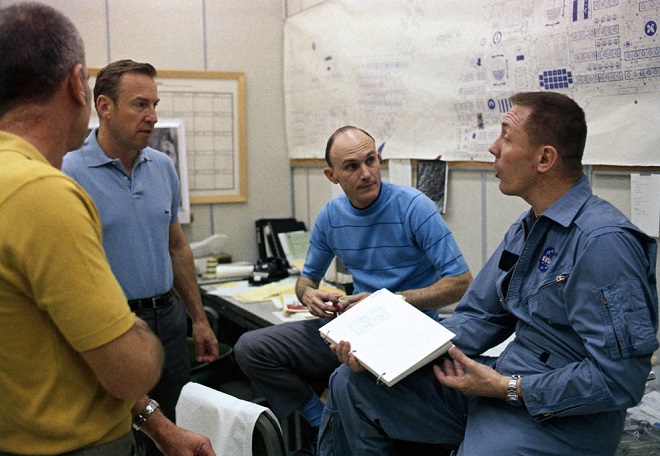
Apollo 13 was launched as scheduled on April 11, 1970, at 2:13 P.M. E.S.T. and was on its way to a planned third landing on the lunar surface.
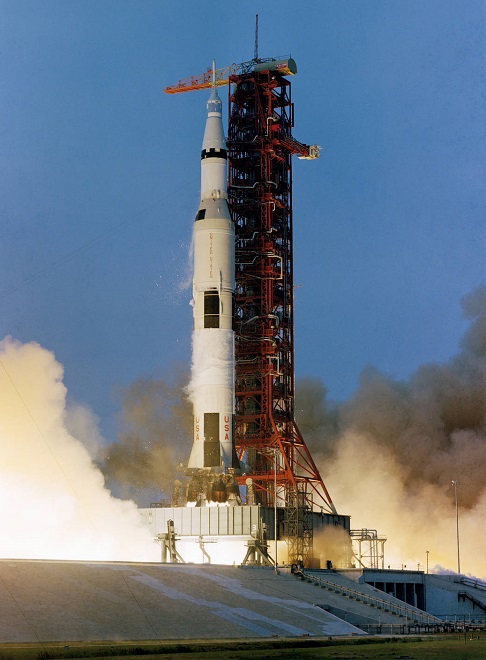
After two successful landings, network television found no sensation in the story of yet another trip to the moon. There was little coverage of the mission’s first fifty-five hours. Then, fifty-five hours and just more than fifty-five minutes into the flight, and just two minutes after fulfilling Mission Control’s request to turn on fans to stir the oxygen tanks so that their contents could be measured, Jack Swigert radioed, “Okay, Houston, we’ve had a problem here.” Then Lovell repeated his message, “Houston, we’ve had a problem.” Within a minute, Fred Haise was listing some metering anomalies and alarm activations for Mission Control and added, “And we had a pretty large bang associated with the caution and warning there.” Apollo 13 was about 205,000 miles from earth—it was just after 10 P.M. E.S.T., April 13, 1970.
Thirteen minutes after the “bang”, Lovell radioed Mission Control while looking out the capsule’s window, “We are venting something out into the…into space.” Apollo 13 was losing it’s oxygen, and its electric supplies. They didn’t know it at the time, but oxygen tank number two had exploded and damaged either a valve or tubing on tank number one—the Command Module’s only other source of oxygen—and both were losing their contents into space. Two of the three fuel cells had failed as well. Without oxygen, the remaining fuel cell in the Service Module would fail to make electricity for operation of the Command Module. Worse yet, the astronauts would not be able to breathe. Without delay, engineers and scientists on the ground went into action to develop alternatives to the original flight plan.
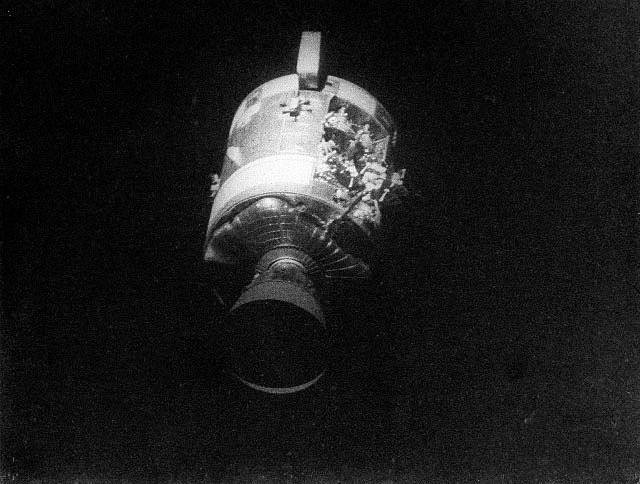
Power in the Command Module had to be conserved for reentry, so with just fifteen minutes of electricity remaining, Lovell and Haise moved into the “lifeboat”, the Lunar Module, and began powering it up while Swigert finished shutting down the systems aboard Odyssey to conserve its remaining energy for the end of the mission. Haise, who had spent fourteen months at Grumman’s manufacturing facility on Long Island, was intimately familiar with the Lunar Module’s operating systems. He powered-up essential systems and began calculating whether the consumables on Aquarius would last for the time it would take to go around the moon and “slingshot” back to earth.
To change the course of Apollo 13 from a moon orbit trajectory to one that would whip around the back of the moon and send them home, Lovell used the Lunar Module’s descent engine to perform a 35-second-long course correction burn. This burn commenced five hours after the explosion at 3:43 A.M. E.S.T. on the morning of April 14. Apollo 13 was then on a free-return trajectory to loop around the moon and return to earth.
Haise had in his possession notes from previous missions which he consulted to determine that they would run out of water about five hours before returning to earth. Fortunately, his notes also showed that the spacecraft’s mechanical systems could remain viable without water cooling for seven or eight hours. Astronauts reduced their water intake to six ounces a day, one fifth of normal, and attempted to compensate by drinking fruit juices and eating wet-packed hot dogs and similar foods. Their efforts to conserve water succeeded, but did lead to the crew becoming dehydrated.
For breathing, there was a sufficient supply of oxygen in the Lunar Module ascent stage where the astronauts would be taking refuge for the remaining four days of the journey. As a backup, there was oxygen in the two suits that were intended for the moonwalk and two more tanks in the ascent stage of Aquarius. Less than half of the oxygen supply was used during the return trip.
Procedures worked out by engineers and tested in a simulator on the ground allowed the crew to use only one fifth of the power normally required during the Lunar Module’s intended forty-five hours of useful life, thus enabling its batteries to last for a ninety-hour-long return trip and add charge to the Command Module batteries—with some energy to spare. To make it back to earth within the ninety-hour time window, the return trip would need to be shortened by nine hours.
The trajectory of Apollo 13’s loop behind the moon had carried them further away from earth than any other humans have ever gone. Two hours after swinging around the moon, Lovell prepared to perform a second burn with the Lunar Module’s descent engine—five minutes in duration—to increase Apollo 13’s return speed and shorten the time it would take to get back home. For navigational alignment during the burn maneuver, debris around the spacecraft made using the sextant to sight stars impossible. Scientists on the ground came up with coordinates allowing Lovell to use the sun as a navigation reference instead. The burn was a success.
Lithium hydroxide canisters remove the carbon dioxide gas, which is continuously produced by the respiration of the astronauts, from the atmosphere of a spacecraft. The Lunar Module’s canisters were designed to protect two astronauts for two days. Because it was being used as a “lifeboat”, Aquarius was hosting three astronauts for four days. After one and a half days of use by three men, an alarm warned that the carbon dioxide levels in the Lunar Module were getting dangerously high. Spare canisters from Odyssey could be used, but there was a problem—they were square, those used on Aquarius were round.
Engineers on the ground went to work using materials that would be available aboard the Apollo 13 spacecraft to improvise a solution. They came up with an adapter design using duct tape, a plastic bag, and cardboard to fabricate a “mailbox” that would attach square lithium hydroxide canisters to the round air handling tubes in the Lunar Module. After testing on the ground, the detailed verbal instructions for constructing the life-saving invention were radioed by Joe Kerwin from Mission Control to Aquarius. Haise and Swigert assembled and installed two of the life-saving devices. Carbon dioxide levels soon dropped back within acceptable parameters.
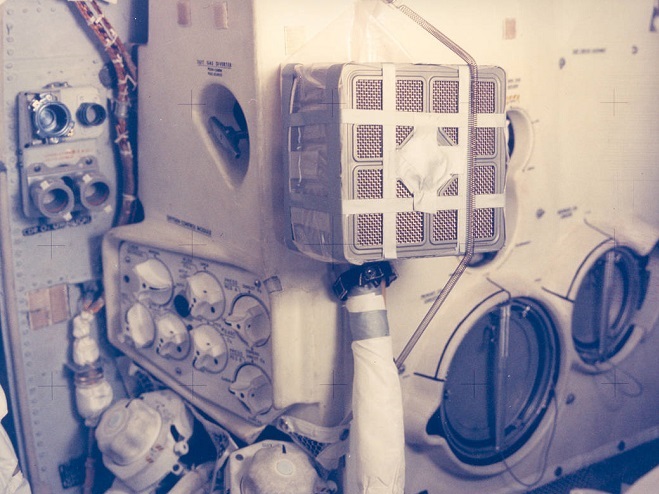
The astronauts endured a lack of sleep, heat, water, and food during the trip home. All were dehydrated and collectively they lost over thirty pounds of body weight. As they approached earth, the crew prepared to implement the new procedures for re-energizing the cold damp systems of the Command Module. Ground personnel had drafted and tested this set of startup instructions in just three days instead of the thirty days that such work usually requires. It was critical that the circuits that were energized did not collectively exceed the amperage available from the batteries on Odyssey.
Jack Swigert carefully brought Odyssey back to life using the new procedures, which were radioed, step by step, from Mission Control. Short circuits, feared due to the moisture that had condensed on all the cold surfaces in the Command Module, were not a problem. Improvements to the insulation on the wiring and electrical components throughout the interior of the space capsules following the Apollo 1 fire is believed to have safeguarded against any mishaps.
Four hours before reentry, at 8:15 A.M. E.S.T. on April 17, 1970, the Service Module was jettisoned and photographed as the crew got its first look at the damage caused by the explosion. Just an hour before reentry, Lovell and Haise joined Swigert in the Command Module. At 11:43, the Lunar Module was jettisoned and drifted away.
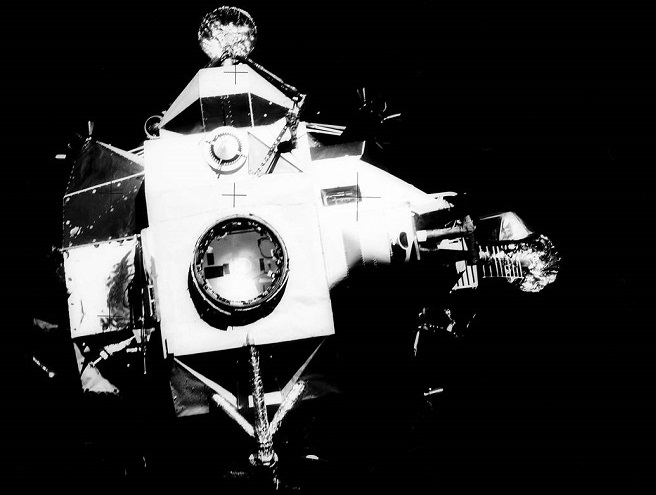
Apollo 13 reentered earth’s atmosphere and experienced the usual communications blackout as the capsule sizzled through an envelope of ionized air. Mission Control and the world rejoiced as cameras televised images of deployed parachutes and a splashdown in the Pacific Ocean less than four miles from the recovery ship, the U.S.S. Iwo Jima, at 1:08 P.M. E.S.T. Possibly as many as one billion people were watching.
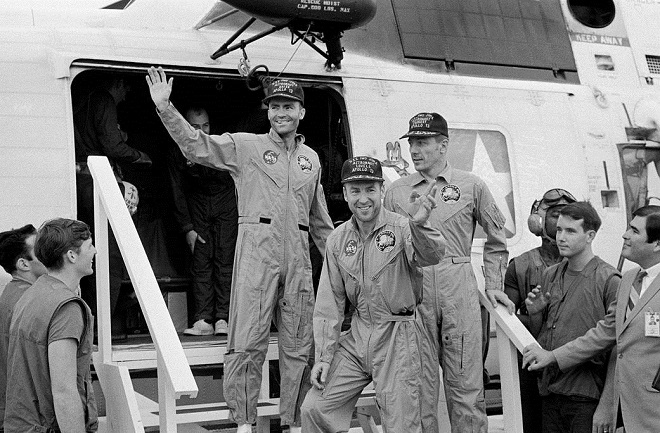
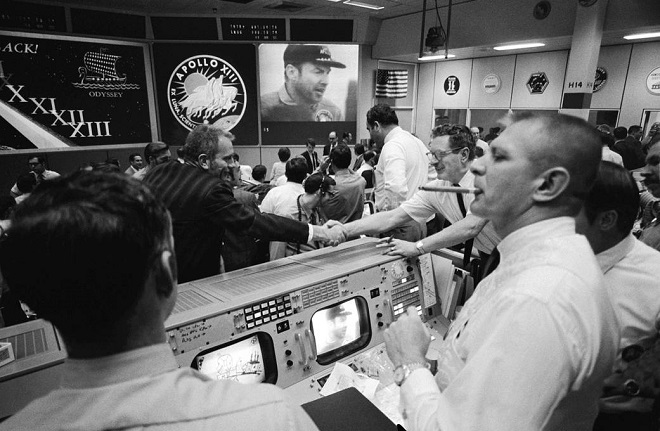
The families of the astronauts had traveled aboard Air Force One along with President Richard Nixon to Honolulu, Hawaii, and were waiting for the Apollo 13 crew when they arrived there from American Samoa on April 18. Nixon presented the men with the Presidential Medal of Freedom.

“…The men of Apollo 13, by their poise and skill under the most intense kind of pressure, epitomize the character that accepts danger and surmounts it…Theirs is the spirit that built America.”
Among the greatest legacies of the earth orbit and moon missions were the scientific and technological achievements that allowed people to live and travel in space using a minimum of resources. Apollo 13 took these minimums to the extreme—using everything as effectively and efficiently as possible. It was one of the pinnacle achievements of the manned spaceflight program.
Fifty years later, are we embracing these and more recent innovations to live comfortably but wisely?
President John F. Kennedy, in his 1962 speech at Rice University, beckoned Americans to strive for a seemingly unreachable goal. A goal that would motivate a people to determine their own destiny and not have destiny determined for them.
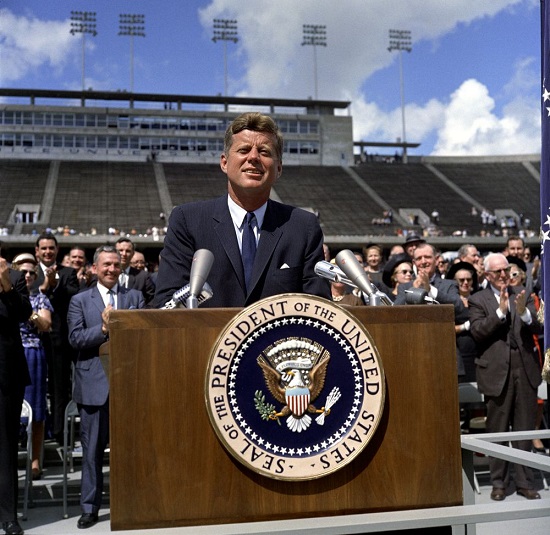
“…We choose to go to the moon in this decade and do the other things, not because they are easy, but because they are hard, because that goal will serve to organize and measure the best of our energies and skills, because that challenge is one that we are willing to accept, one we are unwilling to postpone…”
Kennedy urged his country to take the risk and go to the moon. Despite the dangers, despite the hesitations of the medical community, and in spite of the naysayers, they accepted the challenge and succeeded.
Have Americans lost the will to shape their own destiny? Are they content with blind obedience, mediocrity, and shopping with a dirty rag over their face? Let your friendly editor give you a hint. The people who happen to be front and center in the news today, fifty years after Apollo 13, aren’t rocket scientists. In fact, they have a hard time swallowing anything science has to offer, unless, of course, it can be twisted to back up their sneaky little schemes. But they’re the leadership—elected dimwits and entrenched bureaucrats—and they rule by consent of the governed. So the matter is decided. Look at the bright side though, at least the creeps have a career to protect, so we’ll always be certain of their motivation.
SOURCES
Lovell, James A. 1975. “Houston, We’ve Had A Problem; A Crippled Bird Limps Safely Home”. Apollo Expeditions to the Moon. National Aeronautics and Space Administration. Washington, DC. pp. 247-263.
SOURCES THAT APPARENTLY NOBODY READS
Broseau, Lisa M., and Margaret Seitsema. 2020. “Commentary: Masks-for-all for COVID-19 Not Based on Sound Data”. University of Minnesota Center for Infectious Disease Policy https://www.cidrap.umn.edu/news-perspective/2020/04/commentary-masks-all-covid-19-not-based-sound-data Accessed April 10, 2020.
Davies, Anna, Katy-Anne Thompson, Karthika Giri, George Kafatos, Jimmy Walker, and Alan Bennett. 2013. “Testing the Efficacy of Homemade Masks: Would They Protect in an Influenza Pandemic?”. Disaster Medicine and Public Health Preparedness. 7:4. pp. 413-418.
MacIntyre, C. Raina, Holly Seale, Tham Chi Dung, Nguyen Tran Hien, Phan Thi Nga, Abrar Ahmad Chughtai, Bayzidur Rahman, Dominic E. Dwyer, and Quanyi Wang. 2015. A Cluster Randomized Trial of Cloth Masks Compared with Medical Masks in Healthcare Workers. BMJ Open. 5:e006577. doi:10.1136/bmjopen-2014-006577.
